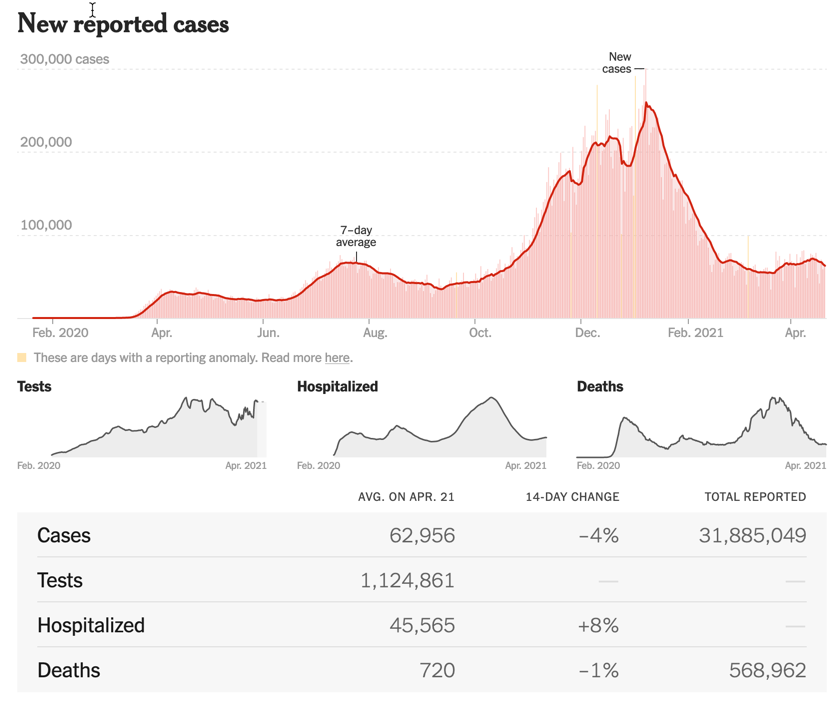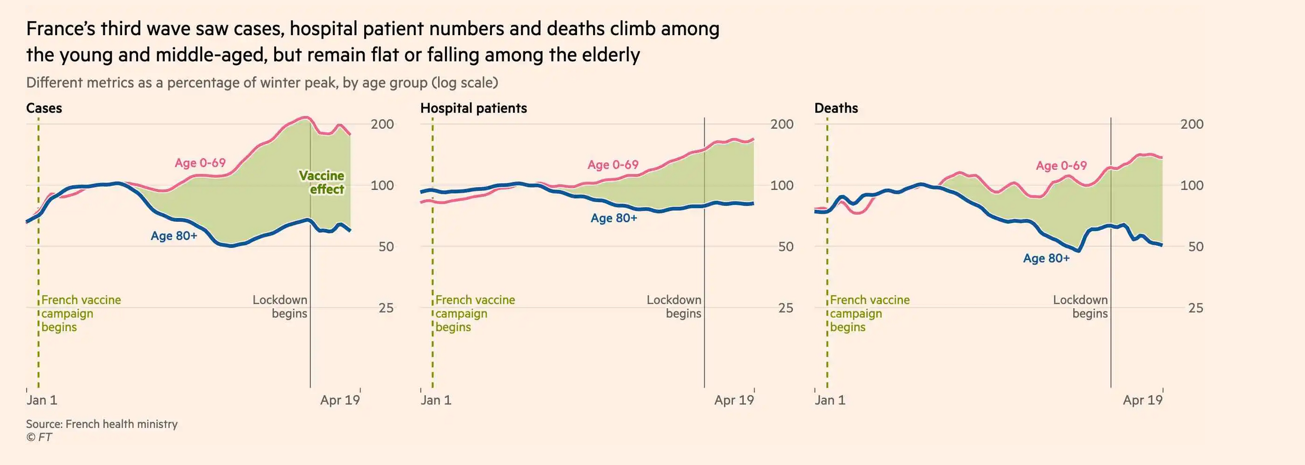Winning the footrace against the variants and approaching the new normal
Winning the footrace
If you look at the SARS-CoV-2 case counts in the United States, they’re flat to declining over the past two weeks. The fourth wave of the coronavirus in the US has been more muted than previous waves.

And while some might not call it a wave because the absolute number of cases hasn’t ballooned, we know that some areas of the US like Michigan have been overwhelmed by this mutant wave just as Canada to the north has.
The jury is still out on how much damage the 4th wave does to public health in the US. But I think we have enough information now to predict with reasonable confidence that this wave will not be destabilizing economically. There will be no new lockdowns and the US is going from strength to strength economically.
Just this morning, the US Labor Department reported that, in the week ending April 17, seasonally adjusted initial jobless claims declined again to 547,000. That’s a further decrease of 39,000 from the previous week’s revised level. And it is the lowest level for initial claims since March 14, 2020, just before lockdowns, when it was 256,000. The 4-week moving average was 651,000, another decrease of 27,750 and a figure much more representative of the beginnings of a true economic recovery.
Without lockdowns from viral waves, recovery can proceed apace.
The vaccines are working
The reality is that countries like the US, the UK and Israel are winning the footrace against Covid-19. And despite the increase of variants of concern, vaccination has been enough of a bulwark against infection that we are unlikely to see the massive waves of infection we saw in previous waves. The FT has the charts to prove it too.


Last week the US passed the vaccine milestone of 200 million doses given. Soon, the US will be in a situation where vaccine supply outstrips demand, where everyone who wants a vaccine can receive one immediately.
Even in Europe, the case counts are receding as the combination of vaccination and the lockdowns work in concert. I want to focus on the vaccine part of this because the FT shows with charts how dramatic an impact it is having in France.

In my view, the end of the tunnel is palpably close. And that means the new normal will be upon us soon.
The New Normal
It’s not clear what business and the economy will look like after the pandemic. But, it’s clear it won’t look exactly like it did before because we have had a whole year to adjust to a wildly different lifestyle during the pandemic. And some of that lifestyle will stick. How much, we don’t know. But some of it will stick. And that means businesses that are viable only because of increased remote and virtual work situations will gain and those that are dependent on people being in close contact will lose some.
I believe the businesses that are the most ‘consumer discretionary’ and require the closest contact with the greatest number of ‘foreigners’ will lose the most. And that’s simply because those businesses present the most risk. And in a world in which coronavirus is contained but not eliminated – as I believe this world will be – those are risks that could mean death. People will think twice about engaging in discretionary activities if it opens them up to catastrophic outcomes.
That’s one variable – how much the new normal is different from the old in terms of public health risk mitigation. A second variable is about financial health risk mitigation. It’s been a great comfort to many that government has stepped in to fill the void when economies shut down. But the pandemic has made clear that financial risk is greater for many than they had assumed. And so to the degree, we have seen greater savings, it’s not clear to me that increased savings will be spent down once we fully re-open the economy.
What’s more is that the lion’s share of savings has been accrued by higher income households with a lower marginal propensity to consume. And so, there’s no reason to believe that they will release these savings once the pandemic has been contained. Think of one outcome as being the addition of Western high income households to the so-called savings glut in Asia. Meanwhile, lower income households are still in a precarious state in the West despite what you might read about people getting government handouts.
What we may find then is that the pent-up demand narrative is a very short-term phenomenon. Once the new normal sets in, the longer-term disinflationary and deflationary trends are likely to re-assert themselves in my view. And that presents a downside risk after the initial burst of spending.
So, I am optimistic about the near term but cautious about whether that translates into meaningful and sustainable economic growth.
Another word on the variants
There are two tracks from the last time I wrote about the virus variants on April 13 that I want to address.
Here’s the first:
we have had a lot more runway than I anticipated. And in Canada, the response has failed. The result is lockdowns, remote learning for children and a delayed full re-opening.
My takeaway from the Canadian situation then is that forewarned is not forearmed if people or governments don’t take the warning onboard. After a year of living through a pandemic, it’s hard to prepare for another lockdown without wanting to scream. And so, at this point, many more stark non-pharmaceutical interventions will likely fail.
And here’s the second:
If we want to think of known unknowns of greater importance, we have to go to Brazil and India, where there is a massive wave of infection going on, likely because of more infectious viral strains and likely creating more infectious strains at the same time.
Let’s take them one at a time.
What I was saying regarding Canada is that modeling good pandemic response protocols is hard. Unless you take preemptive and draconian action from the beginning like New Zealand and Australia, all decisions will present you with a slippery slope on freedom versus coercion and on saving lives versus responding to short-term business considerations.
It’s a lot easier to maintain protocols than it is to develop new ones, particularly when the new ones involve more coercion than the old ones. That’s why lockdowns are radioactive. And it’s also why Australia and New Zealand are winners here, because they haven’t had to resort to lockdowns as much, since they have limited the introduction of new viral cases by closing the borders.
Canada hasn’t done that. And this is one reason they are seeing a spike in case counts. It is the B.117 variant that has become dominant in Canada which has caused the current wave to be so severe. But, there are other variants circulating in Canada as we speak. And they need to win the vaccination footrace to prevent these variants from becoming a problem.
India and mutation
A COVID-19 variant linked to record-breaking case numbers in India has been identified in B.C.
In a prepared statement, a B.C. Ministry of Health official said that 39 cases of the double mutation known as B.1.617 had been found in the province.
These cases were identified at the beginning of April but were not reported because “at the time, B.1.617 had not been identified as a variant of concern or variant under investigation,” the spokesperson said.
I told you last week it was possible that new mutants would pop up in India and Brazil. And they have done – well before I made that statement.
Meanwhile, a shedload of air travel between India and Canada is happening right now even after it has become crystal clear that a massive viral wave is underway there. India just recorded over 300,000 daily cases, the largest day total recorded anywhere and at any time for this pandemic. And everyone in India is talking about the ‘double mutant’ B.1.167 variant that has become the most dominant strain and is believed to be causing the viral wave there.
Now, the good news is that a recent study by the Indian Council of Medical Research shows COVAXIN – the vaccine being used in India – neutralizes multiple variants of SARS-CoV-2 including the double mutant strain. But, there has not been much progress with vaccination in India. So, we are likely to see things there get worse before they get better.
And that means more mutation. And more mutation means more opportunity for the SARS-CoV-2 virus to evade antibodies and maintain itself as an endemic problem.
My View
So, I hope you see how all of this is interconnected. The new normal cannot be like the old normal when the majority of the world is living on the slippery slope of Covid-19 decision-making. Governments somewhere will make trade-offs that practically guarantee that this virus stays with us for the long haul and mutates. And unless, we close the borders the way Australia and New Zealand have done, it’s only a matter of time before those mutated and antibody-evading variants make there way through the population.
What’s more is that vaccine passports will be politically contentious and they won’t be foolproof.
The focus group revealed another unexpected development: Most participants said they would want a fake vaccination card that would allow them to claim they had received shots, after Luntz granted them anonymity to speak honestly.
“One-thousand percent,” one woman said.
“If I have a fake vaccine card, yeah, I can go anywhere,” added a man who said he had turned down free New York Yankees tickets because of the team’s requirement to show proof of vaccination to attend games. Other participants said they wanted a fake card to attend concerts and go on trips, citing the growing number of organizations saying they will require proof of shots.
Even some participants who said they did not intend to get a fraudulent card acknowledged they were tempted. “My faith wouldn’t allow me to be deceitful. So what do I do?” one woman asked the group.
This is the future that awaits us. And, at a minimum, it means public health risks will remain. That practically guarantees the new normal will be different. And it will, therefore, take some unknown ways to adjust to that new normal.
To be continued
Comments are closed.